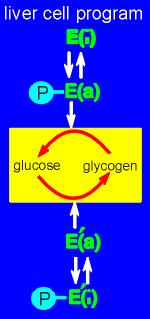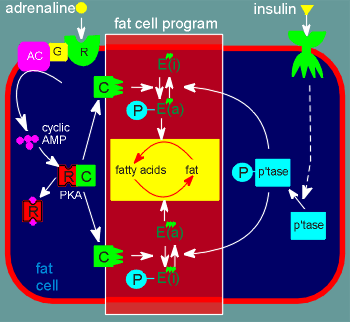
 To the
right is the cell program of a liver cell and a fat cell.
To the
right is the cell program of a liver cell and a fat cell.G protein coupled receptors, and their associated transmembrane signaling equipment and intracellular signaling components, do not create new pathways in a cell.
Rather they feed in on existing pathways to tell a cell how fast and in which direction these pathways should work.
To illustrate this point, consider the function of a liver cell and a fat cell.

 To the
right is the cell program of a liver cell and a fat cell.
To the
right is the cell program of a liver cell and a fat cell.
They look almost identical.
For the liver cell the cellular program is for the production and storage of glycogen and, in a time of need, the breakdown of glycogen to glucose.
The liver cell expresses enzymes to fulfill this function.
One is an enzyme system E for the breakdown of glycogen.
This system is active when phosphorylated (indicated by an "a") and inactive when it is non-phosphorylated (indicated by an "i"). (note: E represents a cascade of enzymes, not a single enzyme).
The liver cell also possess an enzyme system E' for the production of glycogen (active in the non-phosphorylated condition).
The program of a fat cell is remarkably similar....except it expresses an enzyme system E" for production of fatty acids, and not glucose, and an enzyme system E''' for the production of fat from fatty acids.
So, both the liver cell and the fat cell know exactly what they should be doing, namely running their respective cell programs (these programs have been created during evolution and laid down during the process of cell differentiation when it is determined which genes, and thus which enzymes, a cell expresses).
What the liver cell and the fat cell don't know is how fast and in which direction to run their respective programs.
This is where receptors and receptor signaling comes into play (and thus ultimately how the brain and endocrine system controls direction and speed of the cellular programs).
 Lets first consider
the liver cell.
Lets first consider
the liver cell.
Here hormones or neurotransmitters, working through G protein-coupled receptors participate in determining the speed and direction of the cell program.
In a time of need of high glucose levels there is a release of adrenaline which, working through the beta-adrenergic receptor, activates the G protein Gs which in turn activates adenylyl cyclase (AC).
AC stimulates production of cyclic AMP which then binds to the regulatory subunit (R) of protein kinase A (PKA).
The free catalytic subunits (C) of the kinase then phosphorylate enzymes in the liver cell....thus activating the system involved in breakdown of glycogen and, at the same time, inactivating the enzyme system responsible for the production of glycogen (a beautiful example of coordination of metabolic pathways through regulatory systems).
In a time of high plasma levels of glucose there is a release of the hormone insulin which, working through a tyrosine kinase receptor ultimately activates phosphatases (p'tase) responsible for dephosphorylating the same enzyme systems described above (the route to activation of the phosphatases is quite complex and beyond the scope of this tutorial...thus it is given as a dotted line).
This dephosphorylation results in an activation of the pathway for production of glycogen and a simultaneous inactivation of the pathway for breakdown of glycogen to glucose (again, beautiful coordination!).
 Now for the fat cell....notice how similar it is to the liver cell.
Now for the fat cell....notice how similar it is to the liver cell.
Exactly the same regulatory systems are involved ...the same receptors, the same G protein, the same adenylyl cyclase, the same PKA.
The only difference is their cellular programs.
The cells know what to do (i.e. their cellular programs), they simply must be told how fast and in which direction they should do it.
In general, neurotransmitters, neuropeptides and peptide hormones, working through G protein coupled receptors, do not create new pathways but rather regulate the function of existing pathways within the target cells.
In doing so they bring about a coordination of events within the cell and between various organs and tissue within the organism.